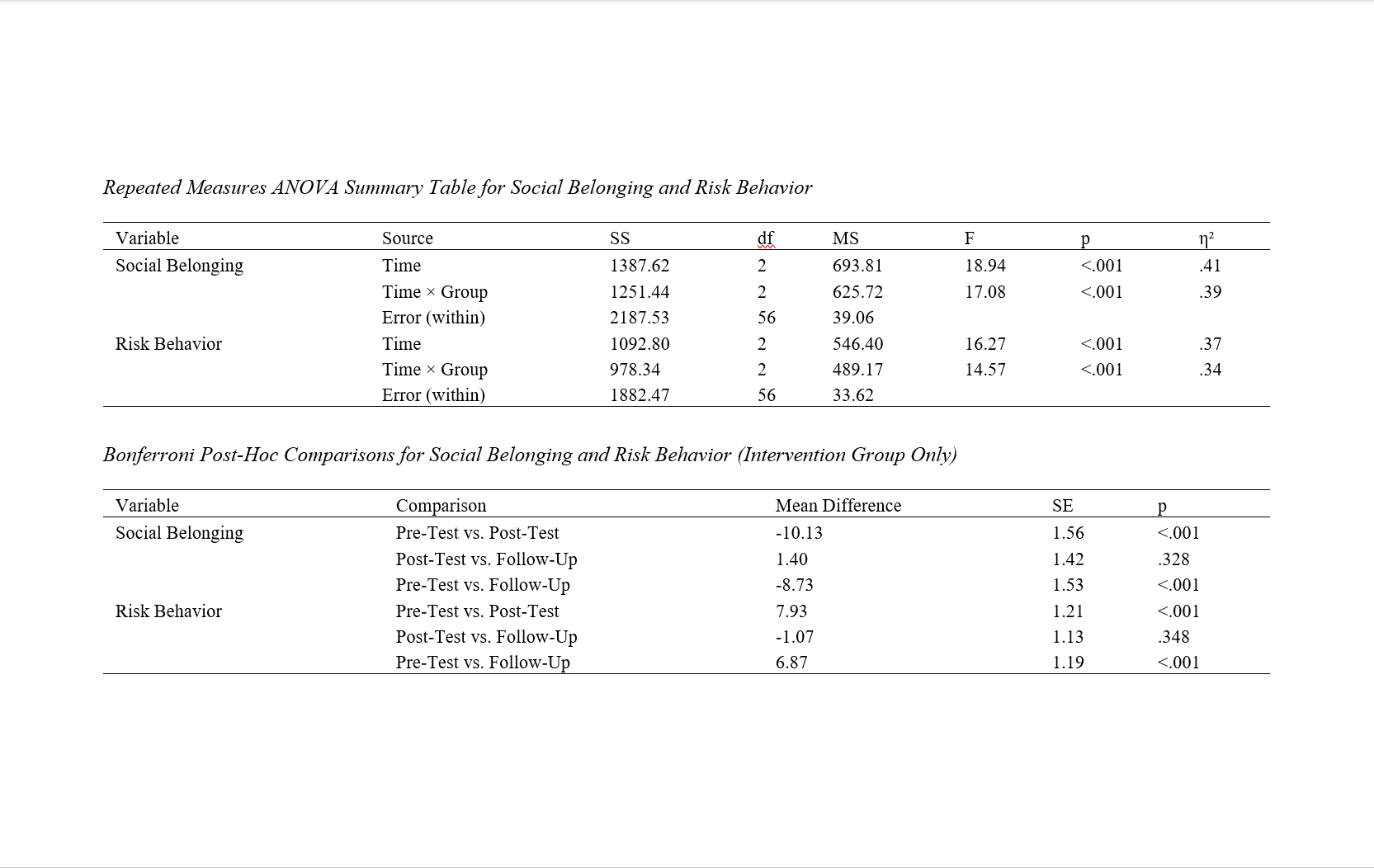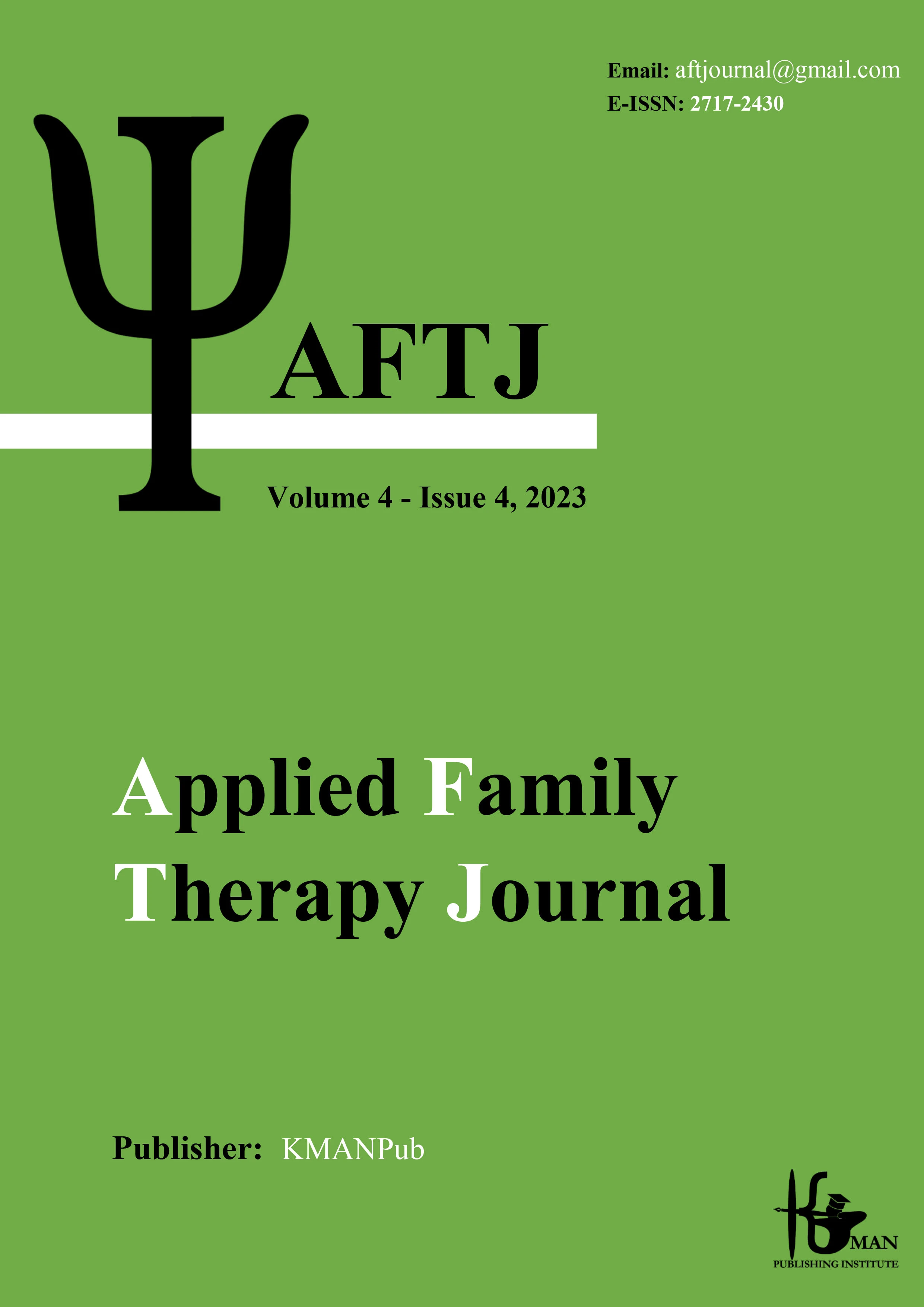Impact of a Peer-Family Connection Program on Social Belonging and Risk Behavior Reduction in Adolescents
Keywords:
Adolescents, Peer Relationships, Family Engagement, Risk Behavior, Social BelongingAbstract
Objective: This study aimed to evaluate the effectiveness of a peer-family connection program in enhancing social belonging and reducing risk behaviors among adolescents.
Methods: A randomized controlled trial was conducted with 30 adolescents aged 13–16 from Hungary, who were randomly assigned to either an intervention group (n = 15) or a control group (n = 15). The intervention group participated in a seven-session, school-based Peer-Family Connection Program designed to improve interpersonal communication, emotional regulation, and relational bonding with peers and caregivers. Sessions were conducted weekly, lasting 45–60 minutes each. Social belonging and risk behavior were measured using validated standardized tools at pre-test, post-test, and five-month follow-up. Data were analyzed using repeated measures analysis of variance (ANOVA) and Bonferroni post-hoc tests in SPSS-27.
Findings: Repeated measures ANOVA revealed a significant interaction effect between time and group for both social belonging (F(2, 56) = 17.08, p < .001, η² = .39) and risk behavior (F(2, 56) = 14.57, p < .001, η² = .34), indicating that the intervention group improved significantly over time compared to the control group. Bonferroni post-hoc analysis showed significant improvements in social belonging from pre-test to post-test (p < .001) and from pre-test to follow-up (p < .001), with no significant decline between post-test and follow-up. Similarly, risk behavior significantly decreased from pre-test to post-test (p < .001) and remained reduced at follow-up (p < .001), with no significant difference between post-test and follow-up.
Conclusion: The Peer-Family Connection Program demonstrated sustained effectiveness in increasing adolescents’ social belonging and reducing their engagement in risk behaviors. These findings support the integration of relational interventions involving both peers and caregivers as a means to promote healthy adolescent development.
Downloads
References
Aderemi, O. N. (2019). Sex Education by Parents and Peers as Correlates of Adolescents Sexual Risk Behavior in Oyo State, Nigeria. https://doi.org/10.20472/tec.2019.008.020
Akintayo, O. T., Atobatele, F. A., & Mouboua, P. D. (2024). Navigating Multilingual Identities: The Role of Languages in Shaping Social Belonging and Political Participation. International Journal of Applied Research in Social Sciences, 6(5), 828-843. https://doi.org/10.51594/ijarss.v6i5.1105
Allen, J. P. (2024). Rethinking Peer Influence and Risk Taking: A Strengths-Based Approach to Adolescence in a New Era. Development and Psychopathology, 36(5), 2244-2255. https://doi.org/10.1017/s0954579424000877
Boer, A. d., Peeters, M., & Koning, I. M. (2016). An Experimental Study of Risk Taking Behavior Among Adolescents: A Closer Look at Peer and Sex Influences. The Journal of Early Adolescence, 37(8), 1125-1141. https://doi.org/10.1177/0272431616648453
Dai, J., Kwon, S. J., Prinstein, M. J., Telzer, E. H., & Lindquist, K. A. (2023). Neural Similarity in Nucleus Accumbens During Decision‐making for the Self and a Best Friend: Links to Adolescents' Self‐reported Susceptibility to Peer Influence and Risk Taking. Human Brain Mapping, 44(10), 3972-3985. https://doi.org/10.1002/hbm.26317
Dekkers, T. J., Popma, A., Sonuga‐Barke, E., Oldenhof, H., Bexkens, A., Jansen, B. R. J., & Huizenga, H. M. (2020). Risk Taking by Adolescents With Attention-Deficit/Hyperactivity Disorder (ADHD): A Behavioral and Psychophysiological Investigation of Peer Influence. Journal of abnormal child psychology, 48(9), 1129-1141. https://doi.org/10.1007/s10802-020-00666-z
Deswinda, D., Machmud, R., Yusrawati, Y., Indrapriyatna, A. S., & Bayhakki, B. (2020). Adolescent Pregnancy Prevention Behavior in Indonesia: Internal and External Factors Influencing. Open Access Macedonian Journal of Medical Sciences, 8(E), 516-520. https://doi.org/10.3889/oamjms.2020.4946
Dittus, P., Li, J., Verlenden, J. V., Wilkins, N., Carman-McClanahan, M., Cavalier, Y., Mercado, M. C., Welder, L. E., Roehler, D. R., & Ethier, K. A. (2023). Parental Monitoring and Risk Behaviors and Experiences Among High School Students — Youth Risk Behavior Survey, United States, 2021. MMWR supplements, 72(1), 37-44. https://doi.org/10.15585/mmwr.su7201a5
Ernawati, E., Mitra, M., Harnani, Y., Nurhapipa, N., & Riva’i, S. B. (2020). Sexual BEHAVIOR IN ADOLESCENT HIGH SCHOOL IN INDRAGIRI HILIR DISTRICT IN 2018. Jurnal Kesehatan Mercusuar, 3(1), 1-10. https://doi.org/10.36984/jkm.v3i1.69
Garthe, R. C., Sullivan, T. N., & McDaniel, M. A. (2017). A Meta-Analytic Review of Peer Risk Factors and Adolescent Dating Violence. Psychology of violence, 7(1), 45-57. https://doi.org/10.1037/vio0000040
Guo, M., Lu, Y., Zhai, R., & Tian, L. (2024). Does Cognitive Control Mediate the Relationship Between Peer Presence and Adolescent Risk‐taking? An ERP Study. Psychophysiology, 61(12). https://doi.org/10.1111/psyp.14675
Harini, R. (2022). Strengthening the Role of Peer Counselors for Reproductive Health Among Adolescent: From Philosophy Into Practice. https://doi.org/10.20944/preprints202206.0327.v1
Hoorn, J. v., Crone, E. A., & Leijenhorst, L. V. (2016). Hanging Out With the Right Crowd: Peer Influence on Risk‐Taking Behavior in Adolescence. Journal of Research on Adolescence, 27(1), 189-200. https://doi.org/10.1111/jora.12265
Kamali, M., & Azmati, R. (2020). The Relationship Between Social Belonging and Social Security in Qom. Applied Geographic Science Research, 4(2). https://openarchive.icomos.org/id/eprint/2822/1/CIAV-Iran-Bulletin-No-10-11-Winter-2023.pdf
Kathy, T., Prinstein, M. J., & Telzer, E. H. (2020). Neurobiological Susceptibility to Peer Influence in Adolescence. https://doi.org/10.1093/oxfordhb/9780198827474.013.27
Kwon, S. J., Kathy, T., McCormick, E. M., & Telzer, E. H. (2020). Neural Correlates of Conflicting Social Influence on Adolescent Risk Taking. Journal of Research on Adolescence, 31(1), 139-152. https://doi.org/10.1111/jora.12587
Mason, M. J., Zaharakis, N., Rusby, J. C., Westling, E., Light, J. M., Mennis, J., & Flay, B. R. (2017). A Longitudinal Study Predicting Adolescent Tobacco, Alcohol, and Cannabis Use by Behavioral Characteristics of Close Friends. Psychology of Addictive Behaviors, 31(6), 712-720. https://doi.org/10.1037/adb0000299
Nie, Y., Wang, G., Pei, C., Wang, L., & Dou, K. (2022). The Association Between Peer Victimization and Risk-Taking Behavior Among Chinese Adolescents: Testing a Moderated Mediation Model. International journal of environmental research and public health, 19(21), 14198. https://doi.org/10.3390/ijerph192114198
Park, H. S., Yeo, H. J., & Jung, S. Y. (2016). A Comparative Study on the Factors Influencing Risk Behaviors of Adolescents Living in Small and Medium-Sized Cities and Rural Communities. Journal of the Korean Society of School Health, 29(3), 256-266. https://doi.org/10.15434/kssh.2016.29.3.256
Patui, N. S., Dasuki, D., & Wahyuni, B. (2018). The Roles of Parents and Peer Friends on Adolescent Premarital Sex Behavior in High School Students of Buol District. Jurnal Kesehatan Reproduksi, 5(1), 50. https://doi.org/10.22146/jkr.37995
Raufelder, D., & Kulakow, S. (2021). The Role of Social Belonging and Exclusion at School and the Teacher–student Relationship for the Development of Learned Helplessness in Adolescents. British Journal of Educational Psychology. https://doi.org/10.1111/bjep.12438
Reyhani, S., & Ahovan, M. (2024). The Effectiveness of Emotional Schema Therapy on Regulating Emotions and Reducing High-Risk Behaviors in Female Adolescents [Research]. Journal of Research in Behavioural Sciences, 22(1), 137-149. https://doi.org/10.29252/rbs.22.1.137
Siraj, R., Najam, B., & Ghazal, S. (2021). Sensation Seeking, Peer Influence, and Risk-Taking Behavior in Adolescents. Education Research International, 2021, 1-8. https://doi.org/10.1155/2021/8403024
Tajabadi, Z., Dehghani, F., & Saehzadeh, M. (2020). The Role of Time Perspective and Peer Rejection in Predicting High-Risk Behaviors of Adolescents of Yazd City. Ranian Journal of Health Education and Health Promotion, 8(2), 129-141. https://doi.org/10.29252/ijhehp.8.2.129
Telzer, E. H., Dai, J., Capella, J. J., Sobrino, M., & Garrett, S. L. (2022). Challenging Stereotypes of Teens: Reframing Adolescence as Window of Opportunity. American psychologist, 77(9), 1067-1081. https://doi.org/10.1037/amp0001109
Telzer, E. H., Jorgensen, N. A., Prinstein, M. J., & Lindquist, K. A. (2020). Neurobiological Sensitivity to Social Rewards and Punishments Moderates Link Between Peer Norms and Adolescent Risk Taking. Child development, 92(2), 731-745. https://doi.org/10.1111/cdev.13466
Triyanto, E. (2023). Identification of Risk Factor of Adolescent Sexual Behavior in Purwokerto: Pilot Study. Jurnal Keperawatan Komprehensif, 9(1). https://doi.org/10.33755/jkk.v9i1.458
Wang, Stanton, Deveaux, Li, X., & Lunn. (2015). Dynamic Relationships Between Parental Monitoring, Peer Risk Involvement and Sexual Risk Behavior Among Bahamian Mid-Adolescents. International Perspectives on Sexual and Reproductive Health, 41(2), 89. https://doi.org/10.1363/4108915
Xu, L. (2023). The Effect of Peer Influence on Risk-Taking Behavior in Adolescents. Lecture Notes in Education Psychology and Public Media, 22(1), 108-112. https://doi.org/10.54254/2753-7048/22/20230239
Yadlosky, L. B., Mowrey, W. B., & Pimentel, S. S. (2023). Risky business: Considerations of emotion regulation and high-risk behaviors in anxious adolescents. Journal of anxiety disorders, 99, 102760. https://doi.org/10.1016/j.janxdis.2023.102760
Zhang, W., & Zhu, L. (2021). The Influence of Peers on Adolescents’ Risk-Taking Behavior and Its Mechanism. Advances in Psychological Science, 29(8), 1462-1471. https://doi.org/10.3724/sp.j.1042.2021.01462

Downloads
Additional Files
Published
Submitted
Revised
Accepted
Issue
Section
License

This work is licensed under a Creative Commons Attribution-NonCommercial 4.0 International License.




















